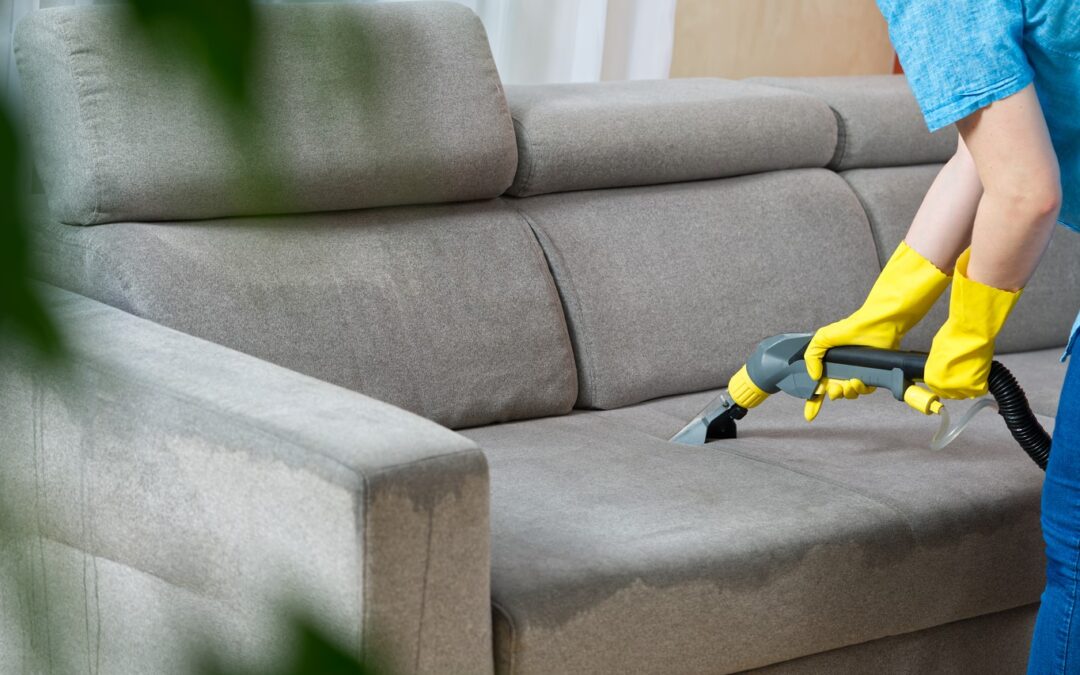Upholstered furniture adds comfort and style to our homes and businesses, but it also requires regular care to maintain its appearance and longevity. Dust, dirt, spills, and everyday wear can quickly age your furniture, making it look worn and tired. Taking the time to clean and maintain upholstery not only enhances its visual appeal but also improves indoor air quality and extends the life of your furniture.
Understanding the right cleaning techniques for your specific upholstery fabric is crucial. Different materials like leather, microfiber, and natural fibres require unique approaches to prevent damage. This guide will help you navigate the complexities of upholstery cleaning with practical advice and step-by-step instructions.
We’ll explore essential topics, such as understanding fabric types and cleaning codes, performing DIY cleaning methods, avoiding common mistakes, and recognizing when to call in professional services. By following these tips, you can keep your upholstered furniture looking fresh, clean, and vibrant for years to come. Whether you are a homeowner looking to maintain your living room sofa or a business aiming to keep office furniture pristine, these techniques are invaluable.
Understanding Upholstery Fabrics and Cleaning Codes
Different types of upholstery fabrics require different cleaning methods to avoid damage and preserve their look. Knowing the type of fabric and the appropriate cleaning code is essential before starting any cleaning project. Here are some common upholstery fabrics and their characteristics:
- Natural Fibres: These include cotton, linen, and wool. They are comfortable and attractive but can be more challenging to clean. They tend to absorb spills quickly, making them prone to stains.
- Synthetic Fibres: Materials like polyester, nylon, and acrylic are more stain-resistant and durable. They are often easier to clean but can still be damaged if the wrong cleaning methods are used.
- Leather: Leather is a durable and luxurious material that requires special care. It should be cleaned using products specifically designed for leather to avoid discolouration or cracking.
- Microfibre: This is a popular choice for its durability and resistance to stains. Microfibre can be cleaned with mild soap and water, but it is essential to avoid over-wetting the fabric.
Upholstery fabrics come with cleaning codes, usually found on the manufacturer’s tag. These codes guide you on how to clean the fabric safely:
- W: Use a water-based cleaning solution.
- S: Use a solvent-based cleaner.
- WS: Either water-based or solvent-based cleaners can be used.
- X: Professional cleaning only; do not use water or cleaning solutions.
By understanding the different types of upholstery fabrics and their specific cleaning codes, you can choose the best cleaning method and avoid potential damage.
Step-By-Step DIY Upholstery Cleaning Techniques
Cleaning your upholstery doesn’t have to be a daunting task. Here are some step-by-step DIY cleaning techniques that you can follow to keep your furniture looking its best.
- Vacuum Thoroughly: Begin by vacuuming the upholstery to remove dust, dirt, and loose debris. Use a vacuum cleaner with a brush attachment to gently clean the fabric without causing damage. Make sure to get into crevices and seams where dirt can accumulate.
- Spot Test First: Before applying any cleaning solution, always perform a spot test on a hidden area of the upholstery. This will ensure that the cleaner does not cause discolouration or damage to the fabric.
- Apply the Cleaning Solution: Based on the fabric’s cleaning code, apply the appropriate cleaning solution lightly to the stained areas. For water-based solutions, mix a small amount of mild detergent with water. For solvent-based options, use a cleaning product specifically designed for upholstery.
- Blot, Don’t Rub: Use a clean, white cloth to blot the stained area gently. Avoid rubbing, as this can push the stain deeper into the fabric. Blotting helps to lift the stain without spreading it.
- Rinse and Dry: If using a water-based solution, rinse the area with a damp cloth to remove any soap residue. Blot the area again with a dry cloth to absorb as much moisture as possible. Let the upholstery air dry completely before using it again.
- Brush and Fluff: Once the upholstery is dry, use a soft brush to fluff the fabric fibres and restore the pile. This gives the furniture a fresh and well-groomed appearance.
Following these DIY cleaning techniques helps maintain the look and longevity of your upholstered furniture, ensuring it remains a comfortable and attractive part of your home or business.
Common Mistakes to Avoid When Cleaning Upholstery
Cleaning upholstery may seem straightforward, but several common mistakes can actually cause more harm than good. Here are some pitfalls to avoid to keep your furniture looking its best:
- Using the Wrong Cleaning Products: It’s essential to use a cleaning product specifically designed for your upholstery fabric. Household cleaners or detergents not meant for upholstery can lead to discolouration, fabric shrinkage, or damage. Always check the label and fabric cleaning code before applying any cleaner.
- Over-Saturating the Fabric: Applying too much water or cleaning solution can cause the fabric to become overly saturated. This can lead to water stains, long drying times, and the potential for mould and mildew growth. Use minimal amounts of liquid and blot instead of soaking the fabric.
- Ignoring Manufacturer’s Instructions: Upholstered furniture often comes with care tags or manuals that provide cleaning instructions. Ignoring these guidelines can result in damage to the fabric. Always follow the manufacturer’s recommendations for the safest and most effective cleaning methods.
- Skipping Regular Maintenance: Failing to clean your upholstery regularly can lead to an accumulation of dirt and stains, making them more difficult to remove. Establish a routine that includes vacuuming and spot cleaning to keep your furniture fresh.
- Using Abrasive Tools: Scrubbing upholstery too hard with stiff brushes or abrasive sponges can damage the fibres and ruin the fabric’s texture. Use soft brushes and gentle motions to protect your furniture.
Avoiding these common mistakes ensures that your upholstery remains in excellent condition, helping you enjoy your furniture for many years.
Benefits of Hiring Professional Upholstery Cleaning Services
While DIY cleaning techniques can be effective, there are significant advantages to hiring professional upholstery cleaning services. Here are some key benefits:
- Expert Knowledge and Equipment: Professional cleaners have extensive knowledge of different fabric types and the best cleaning methods for each. They use specialised equipment and products that are not available to the general public. This ensures a deep clean that can effectively remove embedded dirt, allergens, and stubborn stains without damaging the fabric.
- Time and Convenience: Professional cleaning saves you time and effort. Upholstery cleaning can be a time-consuming task, especially for larger pieces of furniture or extensively soiled items. Professionals can complete the job efficiently, allowing you to focus on other activities.
- Improved Indoor Air Quality: Regular professional cleaning helps to remove dust, pet dander, and other allergens trapped in your upholstery. This can significantly improve the indoor air quality in your home or business, contributing to a healthier environment for occupants and visitors.
- Extending Furniture Lifespan: Proper and regular cleaning by professionals can extend the life of your upholstered furniture. Removing dirt and stains prevents fabric wear and degradation, keeping your furniture looking newer for longer.
- Guaranteed Results: Professional cleaners often provide guarantees for their services. If you are not satisfied with the results, they may offer a re-cleaning or a refund. This gives you peace of mind, knowing that the job will be done correctly.
Hiring professional upholstery cleaning services offers numerous benefits, from expert cleaning and time savings to improved indoor air quality and prolonged furniture life.
Conclusion
Maintaining clean upholstery is essential for both the appearance and health of your home or business. Understanding the fabrics and cleaning codes ensures you use appropriate methods, while DIY techniques help in regular maintenance. Avoiding common cleaning mistakes protects your furniture from damage and extends its lifespan. Despite your best efforts, professional upholstery cleaning offers unmatched, deep cleaning, convenience, and expertise.
For homeowners and businesses in the Brantford area, we at Elite Carpet Care provide exceptional upholstery cleaning services that renew and refresh your furniture. Our team of experts uses advanced techniques and equipment to deliver outstanding results, ensuring your upholstered furniture remains beautiful and durable. Contact us today at 519-900-3978 at Elite Carpet Care to schedule your professional upholstery cleaning service in Brantford and experience the difference!



